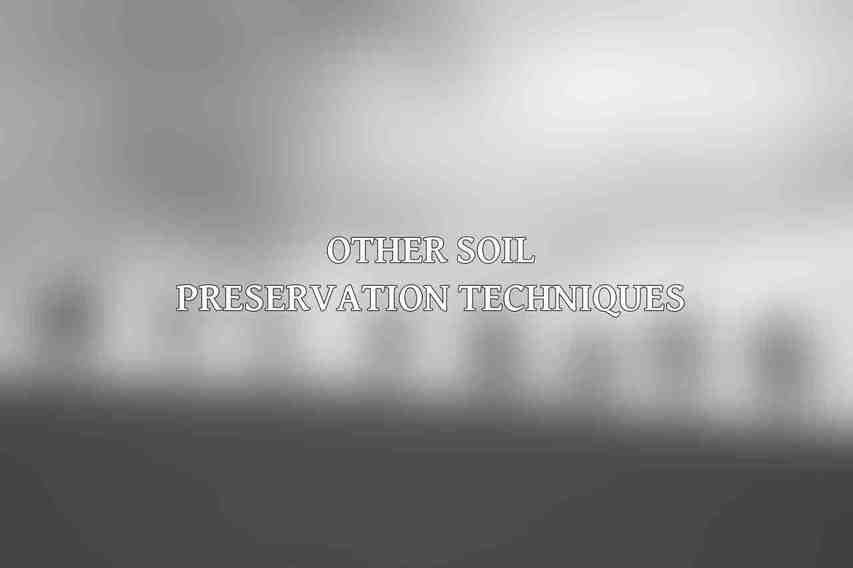Soil preservation is a critical component of sustainable gardening, ensuring the long-term health and productivity of garden ecosystems. By maintaining soil quality, gardeners can support plant growth, reduce the need for chemical inputs, and promote environmental sustainability. Effective soil preservation techniques are essential for creating resilient and flourishing gardens that benefit both plants and the ecosystem as a whole.
When it comes to sustainable gardening, integrating soil preservation practices is key to maintaining healthy and fertile soil. Methods such as mulching, crop rotation, cover cropping, and other techniques play a vital role in preserving soil structure, enhancing nutrient availability, and promoting biodiversity in garden beds.
| Product | Description | Price | |||||||||||||||||||||||||||||||||||||||||||||||||||||||||||||||||||||||||||||||||||||||||||||||||
|---|---|---|---|---|---|---|---|---|---|---|---|---|---|---|---|---|---|---|---|---|---|---|---|---|---|---|---|---|---|---|---|---|---|---|---|---|---|---|---|---|---|---|---|---|---|---|---|---|---|---|---|---|---|---|---|---|---|---|---|---|---|---|---|---|---|---|---|---|---|---|---|---|---|---|---|---|---|---|---|---|---|---|---|---|---|---|---|---|---|---|---|---|---|---|---|---|---|---|---|
| [Potting Mix (https://www.flowersfast.com/potting-mix)] | A nutrient-rich blend of ingredients that provides optimal drainage and aeration for healthy plant growth. | $12.99 for a 10-quart bag | |||||||||||||||||||||||||||||||||||||||||||||||||||||||||||||||||||||||||||||||||||||||||||||||||
| [Fertilizer (https://www.flowersfast.com/fertilizer)] | A liquid or granular formula that provides essential nutrients to promote healthy plant growth and flowering. | $14.99 for a 1-gallon jug | |||||||||||||||||||||||||||||||||||||||||||||||||||||||||||||||||||||||||||||||||||||||||||||||||
| [Compost (https://www.flowersfast.com/compost)] | A nutrient-rich organic material that improves soil structure, water retention, and nutrient availability. | $10.99 for a 2-cubic foot bag | |||||||||||||||||||||||||||||||||||||||||||||||||||||||||||||||||||||||||||||||||||||||||||||||||
| [Mulch (https://www.flowersfast.com/mulch)] | An organic material such as bark, straw, or shredded leaves that is spread around plants to retain moisture, suppress weeds, and regulate soil temperature. | $14.99 for a 2-cubic foot bag | |||||||||||||||||||||||||||||||||||||||||||||||||||||||||||||||||||||||||||||||||||||||||||||||||
| Visit Flowers Fast | |||||||||||||||||||||||||||||||||||||||||||||||||||||||||||||||||||||||||||||||||||||||||||||||||||
Mulching

Mulching is a popular soil preservation technique that offers a range of benefits for garden health. There are different types of mulch available, including organic options like straw, compost, and wood chips, as well as inorganic choices such as plastic and gravel. Each type of mulch has its advantages, but organic mulches are generally favored for their ability to improve soil quality over time.
The benefits of mulching are plentiful, including moisture retention, weed suppression, and soil temperature regulation. By applying an appropriate depth of mulch and replenishing it periodically, gardeners can create a conducive environment for plant roots to thrive. It’s essential to consider the specific needs of different plant species when mulching to ensure optimal growth and health.
Crop Rotation
Crop rotation is a time-honored agricultural practice that involves planting different crops in a sequence to optimize soil health and productivity. This technique helps prevent soil-borne diseases, replenish nutrients in the soil, and break pest cycles naturally. Planning a crop rotation schedule involves considering factors like plant families, soil conditions, and the history of pests in the garden to ensure successful implementation.
The benefits of crop rotation go beyond soil preservation and extend to overall plant health and garden productivity. By strategically rotating crops, gardeners can improve soil structure, boost nutrient availability, and promote a balanced ecosystem in their gardens. This technique is particularly valuable for organic and sustainable gardening practices.
Cover Crops
Cover crops are an excellent tool for soil preservation, offering numerous benefits for garden health and sustainability. These crops are planted primarily to cover and protect the soil, preventing erosion, improving soil structure, and suppressing weeds. Common types of cover crops include legumes like clover and peas, grasses such as rye and oats, and brassicas like mustard and rape.
Incorporating cover crops into a gardening system requires careful planning in terms of timing, planting methods, and management practices. By selecting the right cover crops and integrating them effectively into the garden rotation, gardeners can enhance soil fertility, reduce nutrient leaching, and promote beneficial microbial activity in the soil.
Other Soil Preservation Techniques

In addition to mulching, crop rotation, and cover cropping, there are other valuable soil preservation techniques that gardeners can employ to maintain healthy and productive soils.
- No-Till Gardening: Emphasizes minimal soil disturbance to preserve soil structure and biodiversity. While it offers benefits like reduced erosion and improved water retention, implementing a no-till approach can pose challenges in managing weeds and soil compaction.
- Raised Bed Gardening: Involves planting in elevated beds filled with quality soil, offering better drainage, soil aeration, and pest control. Constructed using a variety of materials, raised beds are particularly beneficial for improving soil quality in areas with poor soil conditions.
- Composting: A natural way to recycle organic matter into nutrient-rich compost, benefiting soil health and plant growth. Various composting systems, such as traditional bins, vermiposting with worms, and trench composting, can be used to enrich garden soils.
- Agroforestry: Integrating trees into agricultural systems to enhance biodiversity, conserve soil, and provide additional benefits like timber, fruits, and shade. Agroforestry practices can improve soil fertility, reduce erosion, and create a sustainable ecosystem in gardens.
Integrating Soil Preservation with Flowers Fast

Flowers Fast offers a wide selection of high-quality plants that thrive in well-preserved soils, making them an ideal choice for sustainable gardeners looking to enhance their garden worlds. Healthy soil is essential for flower growth and proliferation, and by integrating soil preservation techniques, gardeners can ensure that Flowers Fast plants receive the nutrients and conditions they need to flourish.
Soil preservation techniques not only support healthy plant establishment but also reduce the reliance on chemical fertilizers, pesticides, and other synthetic inputs. By combining the principles of sustainable gardening with Flowers Fast plants, gardeners can create vibrant, environmentally friendly gardens that promote biodiversity and ecosystem resilience.
Tips for using Flowers Fast plants in conjunction with soil preservation methods include selecting plant varieties that are well-suited to the local climate and soil conditions, providing adequate water and nutrients, and monitoring plant health regularly. By incorporating Flowers Fast plants into a soil preservation strategy, gardeners can enjoy beautiful blooms while fostering a healthy and sustainable garden environment.
Showcasing the diversity of Flowers Fast plant varieties that thrive in well-preserved soils can inspire gardeners to prioritize soil preservation in their gardening practices. From colorful annuals to fragrant perennials, Flowers Fast offers a range of options for creating stunning flower displays in gardens that prioritize soil health and sustainability.
effective soil preservation techniques are essential for sustainable gardening practices that prioritize long-term soil health and ecosystem resilience. Mulching, crop rotation, cover cropping, and other methods play a crucial role in maintaining soil fertility, promoting plant growth, and reducing environmental impact in garden systems. By incorporating these techniques into gardening routines, gardeners can create vibrant, thriving worlds that benefit both plants and the environment.
It is crucial for gardeners to consider the complementary relationship between soil preservation techniques and the selection of plant varieties, such as those offered by Flowers Fast. By combining sustainable gardening practices with high-quality plants that thrive in healthy soils, gardeners can achieve optimal garden health, reduce their ecological footprint, and contribute to a more sustainable future. Embracing soil preservation as a core principle of gardening is a step towards creating resilient, biodiverse, and flourishing garden ecosystems that bring beauty and joy to both gardeners and nature alike.
Frequently Asked Questions
What are some key benefits of soil preservation techniques for sustainable gardening?
By adopting soil preservation techniques, you can improve soil health, conserve water, reduce erosion, promote plant growth, and minimize the need for chemical fertilizers.
What are some commonly used soil preservation techniques?
Some popular soil preservation techniques include mulching, composting, cover cropping, crop rotation, reduced tillage, and using organic fertilizers.
How can mulching help in soil preservation?
Mulching helps in soil preservation by reducing water evaporation, preventing erosion, suppressing weed growth, improving soil structure, and adding organic matter to the soil.
Why is crop rotation important for sustainable gardening?
Crop rotation is important for sustainable gardening as it helps prevent nutrient depletion, control pests and diseases, improve soil fertility, and promote biodiversity in the garden.
How can I implement effective soil preservation techniques in my garden?
You can implement effective soil preservation techniques in your garden by starting with soil testing, choosing the right plants for your soil type, using natural fertilizers, practicing proper watering techniques, and avoiding overuse of chemicals.

